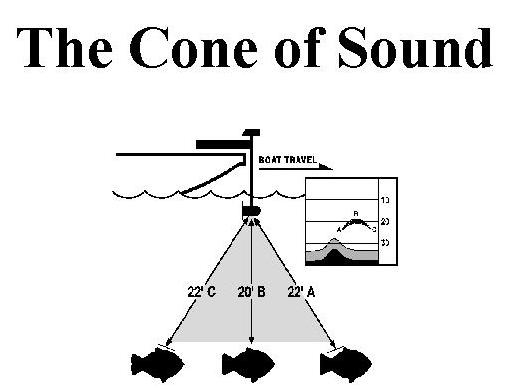Everything you need to know about fish arches

In the 2 decades I have been teaching sonar use and interpretation, the misunderstanding of fish "arches" is still the biggest issue most sonar users have, and it is probably the biggest reason that most anglers do not trust or fully understand what they are seeing on their screens. We've all seen the beautiful ads-a sonar screen full of fish arches. Although you may often see perfect, full arches on your sonar, don't despair if you can't. The geometry of making a fish arch is simple, but must be completely satisfied before a fish arch will appear on your display.
Let's go back a few years to high school geometry class. Remember Pythagoras' theorem? The one that says that in a right triangle the hypotenuse will be longer than its opposite leg? Don't remember? Maybe this will help you understand.
The distance from the tip of the triangle (transducer) to the outside point is longer than the distance from the transducer to the bottom of the cone on a straight line. What does this have to do with sonar and fish arches? Believe it or not it has everything to do with fish arches.
Before we can get to how fish arches are actually made, realize that for a fish arch to form movement must occur relative to the fish and the cone angle. For a perfect fish arch to occur, the fish must move completely through the entire diameter of the cone. A fish that swims into the cone and remains there will show up as a solid line at the same depth. Only as the fish is exiting the cone will an arch form. A fish that only swims through part of the cone will also not show up as a fish arch. A fish must move completely through the entire diameter of the cone for an arch to be formed!
READING SONAR AT HIGH SPEEDNow let's imagine a fish setting still in the lake. Our boat approaches the suspended walleye. As the fish first hits the edge of the transducer's cone, the display shows this contact (A in the illustration). At this point the fish is the farthest it can be from the center of the cone and still be inside the cone. As the boat continues forward, the fish gets closer and closer to the center of the cone, until at a single instant the fish is directly in the center of the cone (B in the illustration). Now the boat continues further forward, causing the fish to get further and further from the center of the cone until the point where the fish is no longer in the cone at all (C in the illustration).
Notice how geometry affects the picture on our sonar display. As the fish enters the cone, swims to the direct center, then goes out the other side, the distance the fish is from the center of the transducer creates a perfect arch. Even though the fish's depth never changes, the distance from the transducer does-further away at the cone's edges and closest in the direct center.
With this is mind it's important to remember a few key points. The true depth of a fish shown on the sonar is the shallowest part of the arch plus about 1 foot! Remember our transducer is about 1 foot under water making the distance to the transducer less than the distance from the fish to the waterline. Also note that the length of the arch only tells us how long the fish stayed in the cone and has no correlation to the size of the fish.
So how do we tell how big a fish is? The larger a target is the stronger the return will be, which the unit displays as a thick mark. The larger a fish is the thicker the mark will be. Determine a fishes' size by the number of vertical pixels a target turns on. A short, thick mark is a bigger fish than a long, thin mark! Today's color units also make it easy to identify a large versus a smaller fish. By using different colors for varying intensity of returns, big fish will be seen as a different color than smaller targets. I like to use Palette 1 on my Lowrance units,which shows bigger fish as yellow.
BASICS TO INTERPRETING SONARNow the most important part about fish arches. If a fish does not move completely across the entire diameter of the transducer cone there will be NO fish arch. That's right no fish arch. But you will see what is probably the most common way of seeing fish on a sonar display-a half arch (see picture to left). This is exactly what it sounds like-half of a full fish arch. These half arches occur when a fish skirts the edge of the cone or moves through only part of the transducer cone.
Now that you understand the geometry of a fish arch, imagine a boat traveling 30 mph across the lake and a walleye slowly cruising at 15 feet deep. How probable is it that these two moving objects-the 5-foot diameter transducer cone and the walleye-will pass perfectly enough to create a fish arch?
Hopefully the above picture looks familiar. Now you know how fish arches are made-and why they sometimes don't show up even when there are fish in the cone. Start looking for half arches, learn how to tell the difference between game and bait fish and you will be surprised at what you start to see.
CHECK OUT THE SONAR INTERPRETATION FEATURE COURSE